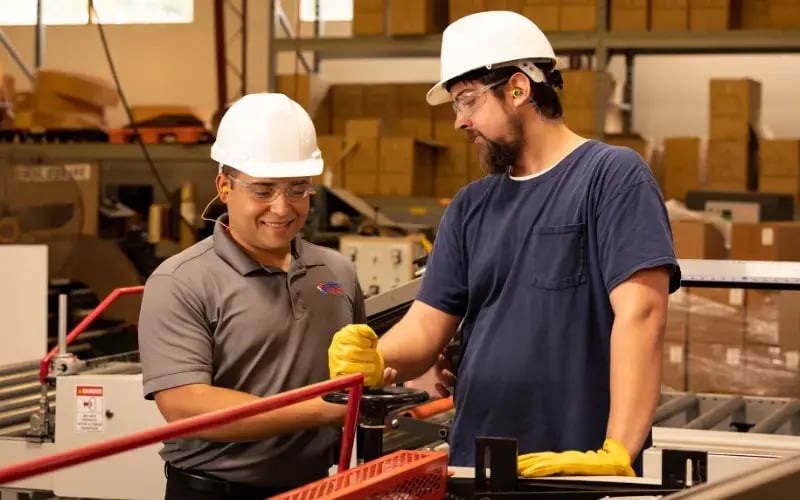Workplace safety isn’t just about hard hats, high-visibility vests, or safety protocols. One of the most overlooked factors in employee wellbeing is ergonomics, the science of fitting the job to the worker. Musculoskeletal disorders (MSDs) and repetitive strain injuries are a major cause of lost workdays and workers’ compensation claims. Many of these issues can be prevented with one essential tool: the ergonomic evaluation.
Why Ergonomic Evaluations Are Essential
Every workplace has risk factors that contribute to pain, discomfort, and injury. Over time, these risks can increase absenteeism, slow productivity, and create avoidable costs in healthcare and claims. Ergonomic evaluations take the guesswork out of solving these problems by:
- Identifying and addressing potential hazards before they cause harm.
- Reducing workers’ compensation claims and associated costs.
- Increasing employee comfort and productivity.
- Improving culture by showing employees that their wellbeing matters.

What’s Involved in an Ergonomic Evaluation
A true ergonomic evaluation goes beyond adjusting a chair or moving a monitor. It’s a systematic review of the worker, their tasks, and their environment. Below are the main components of an evaluation and why each one matters.
Workstation and Environment Review
An evaluator looks at how the physical setup, desks, chairs, tools, machinery, or equipment, affects the worker. Poor workstation design often leads to awkward postures, overreaching, or excessive force.
Task and Job Function Analysis
In a job analysis, tasks are broken down step-by-step to see where risks are hiding. This might include heavy lifting, repetitive motions, or static positions held for long periods.
Learn more about how a job analysis can improve MSD prevention efforts across an organization: What is the Purpose of a Job Analysis
Posture and Movement Assessment
Evaluators observe how employees position themselves while working. Even minor deviations from neutral posture, repeated over time, can create discomfort and injury.
Force, Repetition, and Duration Review
Tasks that require high force, are repeated often, or are performed for long durations increase injury risk. An ergonomic evaluation measures these elements to determine where modifications are needed.
Employee Feedback and Education
An ergonomic evaluation isn’t complete without input from the people doing the work. Employees share where they feel discomfort or strain, and evaluators provide training and education on safe practices. Employees can, and should, provide feedback on potential improvement ideas as well.
Actionable Recommendations
The penultimate step is delivering a plan that outlines adjustments, equipment needs, and process changes. These recommendations are tailored to the specific workplace and worker population.
Implementing Change
Once all the planning, adjustments, and feedback are in place, the most important step can be taken. Actually implementing change. This includes trials for improvement, more feedback, and then the final rollout. The ergonomic process is not an overnight function, but it is an essential, and ongoing one. With continuous monitoring and improvement, even as your company grows, incidents will fall.

Outcomes of Ergonomic Evaluations
When organizations commit to ergonomic evaluations and follow through on recommendations, the benefits extend well beyond immediate injury reduction. The real value lies in how these evaluations safeguard against future costs and wasted time for both injured employees and management overhead.
- Injury Prevention Saves on Claims and Healthcare Costs
Musculoskeletal disorders (MSDs) and repetitive strain injuries are among the most expensive workplace health issues. Once an employee is injured, costs quickly escalate from medical bills, lost productivity, overtime to cover their role, and to potential increases in insurance premiums.
An ergonomic evaluation identifies risks before they evolve into costly claims.
- Reduced Absenteeism and Lost Workdays
Workers suffering from discomfort and pain are more likely to take time off work to recover and take longer to recover. Even minor discomforts, when left unchecked, can lead to time off that impacts schedules and deadlines. Ergonomic evaluations identify these disruptions and create environments where employees can work without discomfort, leading to fewer unplanned absences.
- Lower Turnover and Hiring Costs
High injury rates often push employees out of the workforce, either through burnout, disability, or career changes to accommodate aging or ability. This creates churn that costs companies money in recruitment, onboarding, and training.
When ergonomic risks are addressed, employees stay healthier and happier in their roles. This stability reduces turnover, which protects the company from the major costs of constantly replacing and training new staff.
- Avoiding Costly Retrofits and Large-Scale Changes
Without ergonomic evaluations, companies miss the opportunity to address systemic problems before they develop into major financial burdens. By then, fixing the issue may require large-scale redesigns, equipment replacements, or facility overhauls.
Proactive evaluations give companies the ability to catch these risks early, when the solutions are far less expensive. Even understanding risks gives companies the opportunity to initiate and push for change when it is feasible. If employers are unaware of risk when budget season rolls around, they won’t be able to take the necessary steps to fix it.
- Protecting Long-Term Business Sustainability
As industries evolve, the physical and cognitive demands on workers will change. Companies that embed ergonomic evaluations into their processes create a sustainable framework for adapting to these shifts. This future-proofs the workplace by ensuring that risks are managed continuously, not reactively.
Future-Proof, Today
Think of an ergonomic evaluation not as a one-time fix, but as the foundation of a safer, healthier workplace. When done thoroughly and followed by consistent action, it becomes a measure you can use to keep employees safe now, and in the future, establishing a system that prevents issues before they arise.
Investing in ergonomics is investing in people.
Industrial and Office Workplace Ergonomics Consultations
Briotix Health offers ergonomics services and consulting for every work environment. These services are designed to identify ergonomic issues and risks associated with jobs and job tasks, deliver objective measures of that risk, and provide risk reduction recommendations at scale.